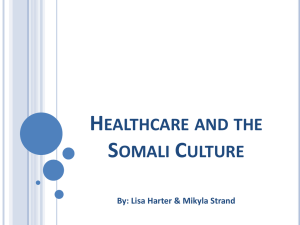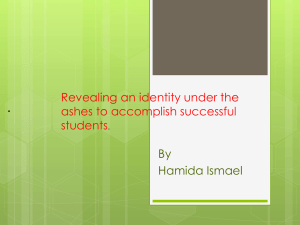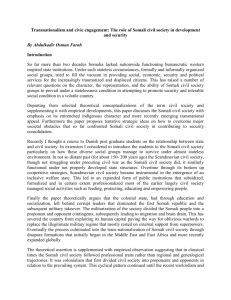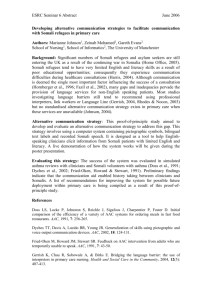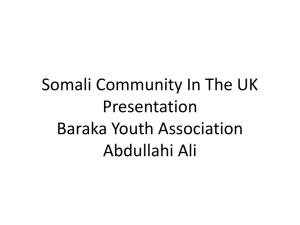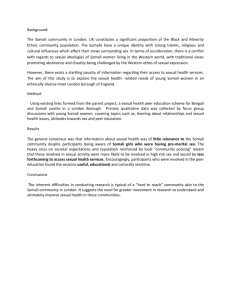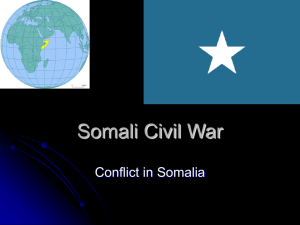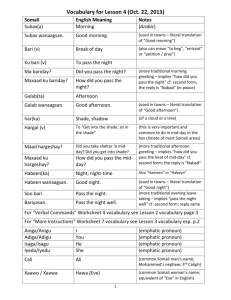Somali Immigrant Settlement - Academic Program Pages at Evergreen
advertisement
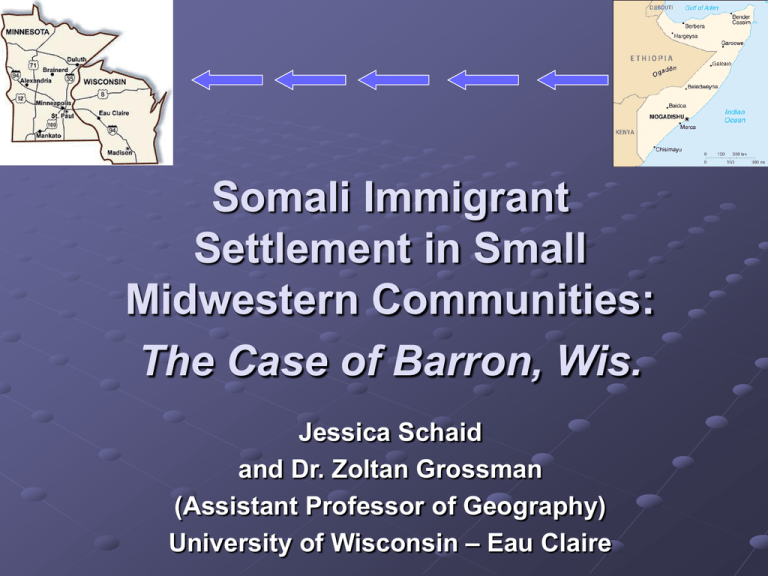
Somali Immigrant Settlement in Small Midwestern Communities: The Case of Barron, Wis. Jessica Schaid and Dr. Zoltan Grossman (Assistant Professor of Geography) University of Wisconsin – Eau Claire Somali Refugees After civil war broke out in Somalia in 1991, 800,000 refugees fled. 450,000+ were in refugee camps by 2000 (mainly in Kenya) At least 29,000 were resettled in the U.S. (with the largest group to Minnesota), followed by family members. KENYA Somali Resettlement Somalis have been drawn by the Twin Cities’ job market, schools, service agencies for refugees (Half of recent MN immigrants are refugees.) Minneapolis-St. Paul has become a de facto “capital” of Somalis in North America, with an community estimated at tens of thousands Urban-to-Rural Migration Somali refugees have recently settled in smaller communities around the Twin Cities. Some move directly from elsewhere in U.S. Immigration Hinterland: Rural ethnic mix resembling Twin Cities (Mexicans, Hmong, Somalis, etc.) Southern Minnesota Rochester St. Cloud Owatonna Waseca Marshall Faribault Mankato Western Wisconsin Barron Hudson (briefly) Others in the future…? Somali soccer team in St Cloud, Minn. “Push Factors” from Twin Cities Growing competition for unskilled jobs Need English, driver’s license Some factory jobs moving to rural areas Crime rate “Pull Factors” to smaller towns Job opportunities in meatpacking industry & other plants, due to labor shortage Jobs do not need high level of skills, English proficiency Less crime; quieter; Can walk to work/school Intervening Obstacles: Visible Minority Like other recent immigrants in rural areas (Latinos), Somalis have faced cultural conflicts. Somalis face greater conflicts due to their race and Muslim religious identity. Intervening Obstacle: Negative Media Images The cultural and religious gap has been widened by movies, such as Black Hawk Down, that do not realistically represent Somalis. Minnesota Somalis faced intensified government scrutiny and public suspicions after 9/11. Conflicts over Somali Immigration In 2002, the Mayor of Lewiston (Maine) and white supremacist groups asked Somalis to stop settling in the city. In Jan. 2003, a crowd of 4,000 rallied to support the Somalis. Lewiston, Maine Conflicts over Somali Immigration Several acts of racist grafitti and arson in St. Cloud, Minn., were aimed at Somali businesses in 2002. The community has been working with the St. Cloud Area Somali Salvation Organization (SASSO) to build understanding. Somalis in Barron, Wis. 13% of total population of 3,000, working at meatpacking plant facing labor shortage Immigrant workers offset loss of population, tax base Strengthening of Somali cultural unity “Pull Factors” to Barron “Turkey Capital” of Wisconsin Jennie-O Turkey Store employment Jennie-O Turkey Store in Barron, where about 350 Somalis work Lower standards than Minnesota for driving & high school graduation (incl. older students) Intervening Obstacles: Uncooperative institutions No mosque building available No Somali foods in grocery stores No invitations to weekend community festivals Invisibility of “Visible Minority” Somalis cannot stay in Barron on weekends Go to Twin Cities to visit, shop, and worship Lack of social interaction with Americans in Barron Intervening Obstacle: Housing Housing shortage in Barron for Somalis Most Somalis live in one apartment bloc Some commuting from nearby Cameron, Rice Lake, Menomonie, etc. (secondary diffusion) Intervening Obstacle: Tensions in high school Students’ lack of awareness of Somali culture Resentment of head covering, “privileges” Fights in Fall 2001 Somali flag desecration incident Conflict resolution in high school Superintendent Monti Hallberg lived in Muslim countries School records from Kenyan refugee camps School staff training/ cultural day Multiethnic soccer team Responses: Preparing community agencies Local governments, State/federal agencies, Schools, Businesses, Health clinics, Churches, Legal aid, Law enforcement Responses: Educating Somalis International Center in Barron (Catholic Herald). Enable Somalis to adapt. International Center (Workforce Resource) Somali & American staff Teaching immigrants: English skills Computer skills Job skills Cultural skills Driving skills Shortcoming: Outreach to Americans Barron relying on public forums and discussions that draw mainly enlightened residents. Does not challenge Americans’ preconceptions. Wisconsin students’ Images of Somalia Other Survey at UWEC Poverty Famine Violence/ war Desert/ heat Poverty and Not images of Famine images violence & war Wisconsin Students’ Image Sources Other Survey at UWEC Children's’ Fund ads News/ Media Black Hawk Down School Recommendations: Proactive education of Americans Develop programs/ materials, educational curriculum Go into schools, clubs in new communities Teach Americans on: Somali culture, Somali history, Islamic values, Immigration patterns, Easing the transition Goals of Research To examine the push-and-pull factors that influence the migration of Somali refugees to small Midwestern communities. To examine how factors such as age, regional origin, gender, English proficiency, etc., have influenced Somali migration to and within the Midwest. Goals of Research (cont.) To compare and contrast the experiences of Somali refugees in larger cities and smaller communities. To issue recommendations to rural communities and schools anticipating new Somali residents. Methods of Research Journal and newspaper articles. Interviews with Somali group leaders, other Somali immigrants, and local American leaders and residents. Nasra Xashi (International Center) and Jessica Schaid (UWEC) Methods of Research (cont.) A bilingual questionnaire for Somali residents, asking about their experiences in migrating to small Minnesota or Wisconsin communities. Additional materials supplied by local communities and agencies, including survey of mayors & school superintendents Presentation of Research The research will be presented in a paper that will be submitted to academic journals for publication. The research will also be presented at the Student Research Day at U.W.-Eau Claire and at national and/or international conferences. This project is made possible with funding by the UWEC Center of Excellence for Faculty/Student Research Collaboration Proposal and bibiliography at www.uwec.edu/grossmzc/somali.html This PowerPoint at www.uwec.edu/grossmzc/Somalis.ppt Jessica Schaid, student researcher schaidje@uwec.edu 715-838-1237 Dr. Zoltán Grossman, Assistant Professor of Geography grossmzc@uwec.edu 715-836-4471 www.uwec.edu/grossmzc
